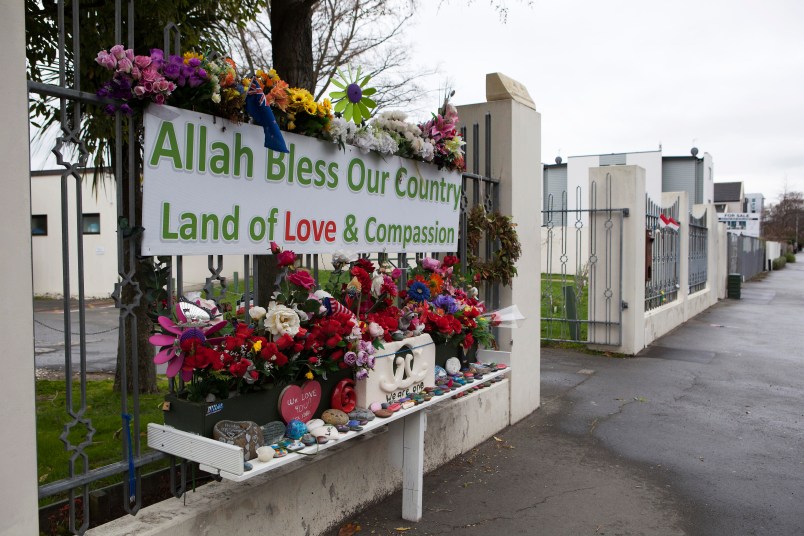This article is part of TPM Cafe, TPM’s home for opinion and news analysis. It is excerpted from Culture Warlords: My Journey Into the Dark Web of White Supremacy by Talia Lavin. Copyright © 2020. Available from Hachette Books, an imprint of Hachette Book Group, Inc.
In the summer of 2019, white supremacists felt constrained by widely publicized — if in practice halfhearted—attempts to curb the spread of racist and conspiratorial rhetoric on mainstream social-media sites like Twitter, Facebook, and YouTube. While white-supremacist foot soldiers continued to maintain a robust presence on mainstream social media, they also began to seek alternatives.
They started casting doubt on long-established hubs, like the anonymous message boards 4chan and 8chan. The chatting app Discord—popular among video-game enthusiasts—had previously served as a key hub for far- right discussion online, including much of the planning of the fatal “Unite the Right” white-supremacist rally in Charlottesville, Virginia, in August 2017. But a mere two days after the attack in which Heather Heyer died and dozens more were severely injured, an antifascist media organization called “Unicorn Riot” began to release an enormous cache of Discord chats between members of the far right.
Unicorn Riot eventually set up a publicly searchable database of far-right Discord messages; “Unicorn Riot Discord Leaks opens far-right activity centers to public scrutiny through data journalism,” the organization wrote in its description. This proved true: The chats, which had been conducted with the presumption of privacy and thus contained free-wheeling far-right discourse, led to the identification and outing of dozens of white supremacists around the country, both by antifascist activists and by journalists reporting on hate movements in the United States.
In June 2019, I stumbled across a thread on 8chan in which users expressed their concern about the number of “shills” who had begun to surveil the anonymous board after it served as a platform for Brenton Tarrant, a mass shooter who murdered over fifty Muslims at prayer in Christchurch, New Zealand, to post his manifesto. As a result, 8channers were looking for other options to express their opinions online and reach one another; Discord had proved too easy to infiltrate. (After the third mass shooter in several months uploaded a manifesto and livestream of his acts to 8chan, the message board was pushed offline by its internet service provider.)
Ultimately, some users settled on the encrypted messaging app Telegram. The app was launched in 2013, and rose to prominence as a platform for political expression in Russia; it battled Russian authorities in court over its refusal to hand over its encryption keys to Russian authorities. (As a fact checker for the New Yorker, I spoke to numerous Russian dissident sources on Telegram, including a Chechen fixer who had to flee the country after our article, critical of local dictator Ramzan Kadyrov, was published.) But such a staunch commitment to privacy has its downsides: In 2019, Telegram became a prominent gathering place for far-right extremists who faced or feared censorship on social media. On the 8chan thread, users listed Telegram channels in which they sought to gather.
Altogether, beginning on June 1, 2019, I joined more than ninety far-right groups on Telegram, a plurality of the English-language channels listed on the 8chan thread, as well as groups I found through groups I joined. I also found a number of these chats through a channel called “Procurement,” which offered lists of far-right channels and dubbed itself a “free speech platform.”
My intent in joining these groups was to gain a fly-on-the-wall view of far-right rhetoric, surveilling its violence, racial animus, and anti-Semitism in an environment in which contributors felt safe to speak freely, embracing the new platform on which they found themselves and connecting enthusiastically with one another. I didn’t participate in these ever-moving conversations, just lurked as “Tommy,” an anonymous fellow with a picture of a banana as his avatar. The vast majority of participants in the chats and subscribers to the channels were similarly anonymous, so such an obscured identity did not attract undue attention. I utilized a fake phone number generated by an app to obscure my own identity still further.
A Southern Poverty Law Center report, published on June 27, 2019, revealed that the neo-Nazi website the Daily Stormer had warned its fans in August 2018 that the “SPLC Is Monitoring You” on the chat app Discord, and lauded Telegram’s end-to-end encryption as an alternative for white nationalists. The SPLC report added that Telegram posed particular dangers, compared to message boards like 8chan: On the app, “extremists can connect in channels that post publicly facing propaganda and then organize privately on the same app by using its encrypted chat feature, where plans to commit acts of terror can go undetected by law enforcement agencies.”
In my experience, a chaotic mix of memes, calls for violence, and detailed dossiers on prospective “enemies” were characteristic of far-right Telegram channels. The channels’ names were evocative, and many of them focused purely on spreading anti-Semitic propaganda. On 8chan, a graphic surfaced listing fifteen Telegram channels, grouped under the label “Guild of Counter-Semitism.”
Another graphic mapped out a network meant to guide Telegram users through an ideological journey of radicalization, starting from “entry-level redpills” and advancing to channels about the “gay trans agenda” and “based screencaps and good reads” (based being a frequently used far-right term for “ideologically far-right”). I also encountered a channel run by Paul Nehlen, once a congressional primary challenger to Paul Ryan endorsed by Donald Trump, whose virulent anti-Semitism saw him banned from Twitter and the Wisconsin Republican Party. I joined Gen Z Y K L O N; K i K e S C e N T R a L; Jewish Ritual Murder Abortion Satanism Pizzagate; Judenpresse Monitor/Archive; Holohoax Memes & Info; Jews Own USA (Wars Media Banks). A chat called “MakeAmerica110” was named after a frequently floated white-supremacist statistic—that Jews had been expelled from 109 countries.
They wanted to make America the next. The chats varied in membership, with some as small as twenty-two members and others as large as five thousand members. Some were open chats, where users could converse with one another. Others operated as feeds, with memes, news links, videos, social-media posts, and rants spread to subscribers by an individual channel operator. Altogether, as of June 5, 2019, the chats I’d joined collectively had 32,380 members. A study by the reporter Tess Owen of Vice News, published in October 2019, did a sweeping analysis that proved Telegram was growing exponentially in 2019 as a platform for the far right, as extremists were pushed off mainstream social media platforms like Facebook and Twitter. One channel Owen observed had ten thousand members that it reached multiple times a day.
Over two-thirds of 150 far-right channels Owen examined had been created in 2019; 22 were created in the month after the Christchurch, New Zealand, white-nationalist massacre perpetrated by Brenton Tarrant. Eighty-two of the 150 channels examined in total had appeared after Christchurch, and as such were focused on preparing for violent action—disseminating instructions for how to build pipe bombs and homemade guns, survivalist manuals for the coming race war, and, Owen writes, guides to prepare for committing a mass shooting.
Talia Lavin is a Harvard University alum and freelance writer with nearly 114,000 Twitter followers who has had bylines in The New Yorker, The New Republic, The New York Times Review of Books, Washington Post, Village Voice and more.









